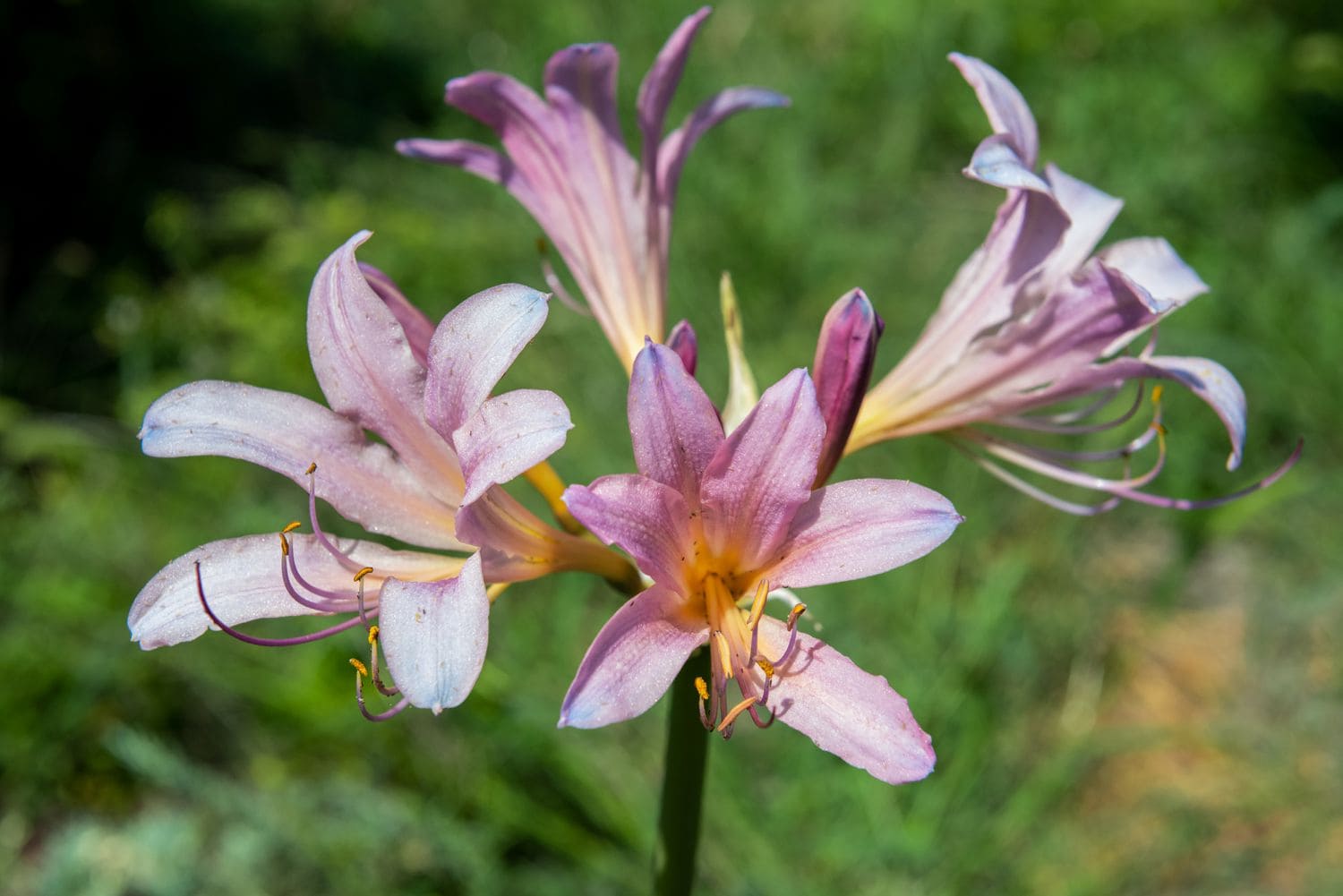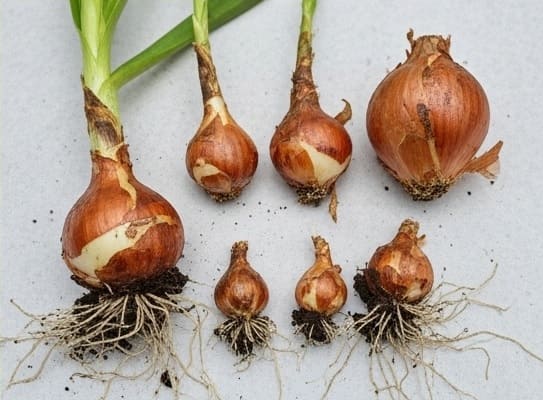Picture this: It’s a scorching August afternoon, and your garden looks tired after months of summer heat. Most perennials have finished their show, leaving behind a landscape that feels ready for autumn’s arrival.
Then, seemingly overnight, elegant pink trumpets emerge from bare ground like botanical magic tricks. No leaves, no warning—just pure floral drama rising from what appeared to be empty soil.
This is the enchanting world of surprise lilies, and once you experience their unexpected beauty, you’ll understand why gardeners have been captivating by these mysterious plants for generations.
A Plant with Many Names and a Fascinating History
I still remember the first time I encountered surprise lilies in my grandmother’s garden. As a curious eight-year-old, I was convinced someone had played an elaborate prank—how else could flowers simply appear where nothing had been growing just days before?
It wasn’t until years later that I learned about their fascinating life cycle and why they’ve earned such colorful names as “resurrection lily,” “magic lily,” “naked ladies,” and the whimsical “upstart.”
The abundance of common names reflects both the plant’s mysterious nature and its journey through American gardens. When Captain William Roberts brought three bulbs from Japan to his niece in 1854—just after Captain Matthew Perry had opened Japanese ports to foreign trade—these plants were destined to become garden legends.
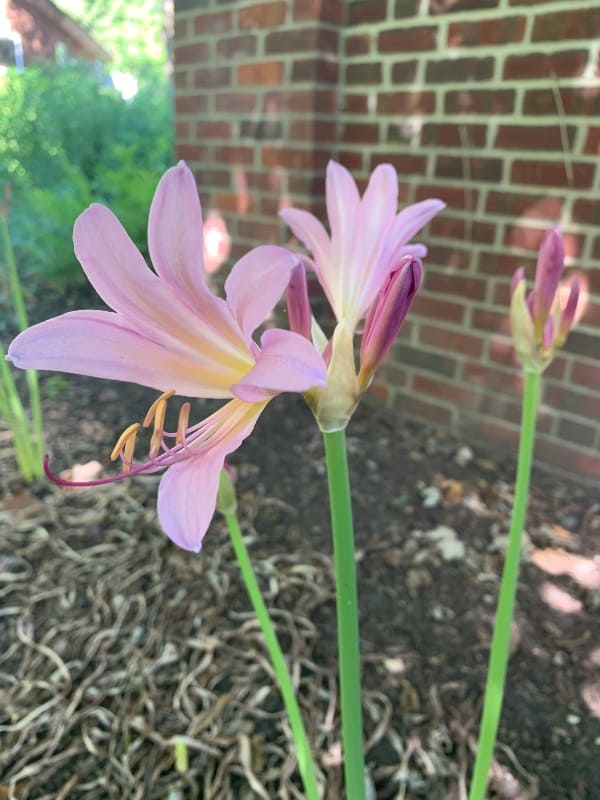
Originally misidentified and sold as Amaryllis halli, they’ve been passing from garden to garden ever since, earning new nicknames with each generation of gardeners who discovered their magic.
Despite their common name, surprise lilies aren’t actually lilies at all. They belong to the Amaryllis family (Amaryllidaceae), and their scientific name, Lycoris squamigera, honors a Roman actress who was Mark Antony’s mistress.
The species epithet “squamigera” means “bearing scales,” referring to the tiny iridescent scales on the flower petals that create their distinctive shimmer.
These particular plants are botanical anomalies—they’re sterile triploids with three sets of chromosomes instead of the usual two, which explains why they never produce seeds and must spread entirely through bulb division.
The Great Disappearing Act
What makes surprise lilies truly extraordinary is their unique growth pattern—a botanical magic show that unfolds in three distinct acts across the growing season:
Act 1: Spring Emergence
Spring Emergence begins in late winter when thick, strap-like leaves push through the soil. These silvery-green leaves grow in attractive clumps, reaching about 12 inches long and 1 inch wide.

Many gardeners initially mistake them for oversized daffodil foliage, wondering when the flowers will appear. The leaves work diligently through spring, photosynthesizing and storing energy in the large bulbs below—bulbs that can reach three inches in diameter.
Act 2: The Vanishing
The Vanishing occurs as temperatures rise in late spring and early summer. The foliage begins to yellow and disappear completely by late May or early June, leaving no trace above ground. To the uninitiated, it appears the plant has simply died.
This disappearance is actually a survival strategy, allowing the plant to avoid stress during the hottest, driest part of the year.
Act 3: The Surprise
The Surprise comes after 8-10 weeks of apparent dormancy, typically in the last days of July through mid-August. Bare flower stalks shoot up from the ground with remarkable speed—sometimes growing several inches in a single day.
Within days, these 18-24 inch stems are crowned with clusters of 4-8 fragrant, trumpet-shaped blooms in shades ranging from pale pink to deep rose with hints of lilac.
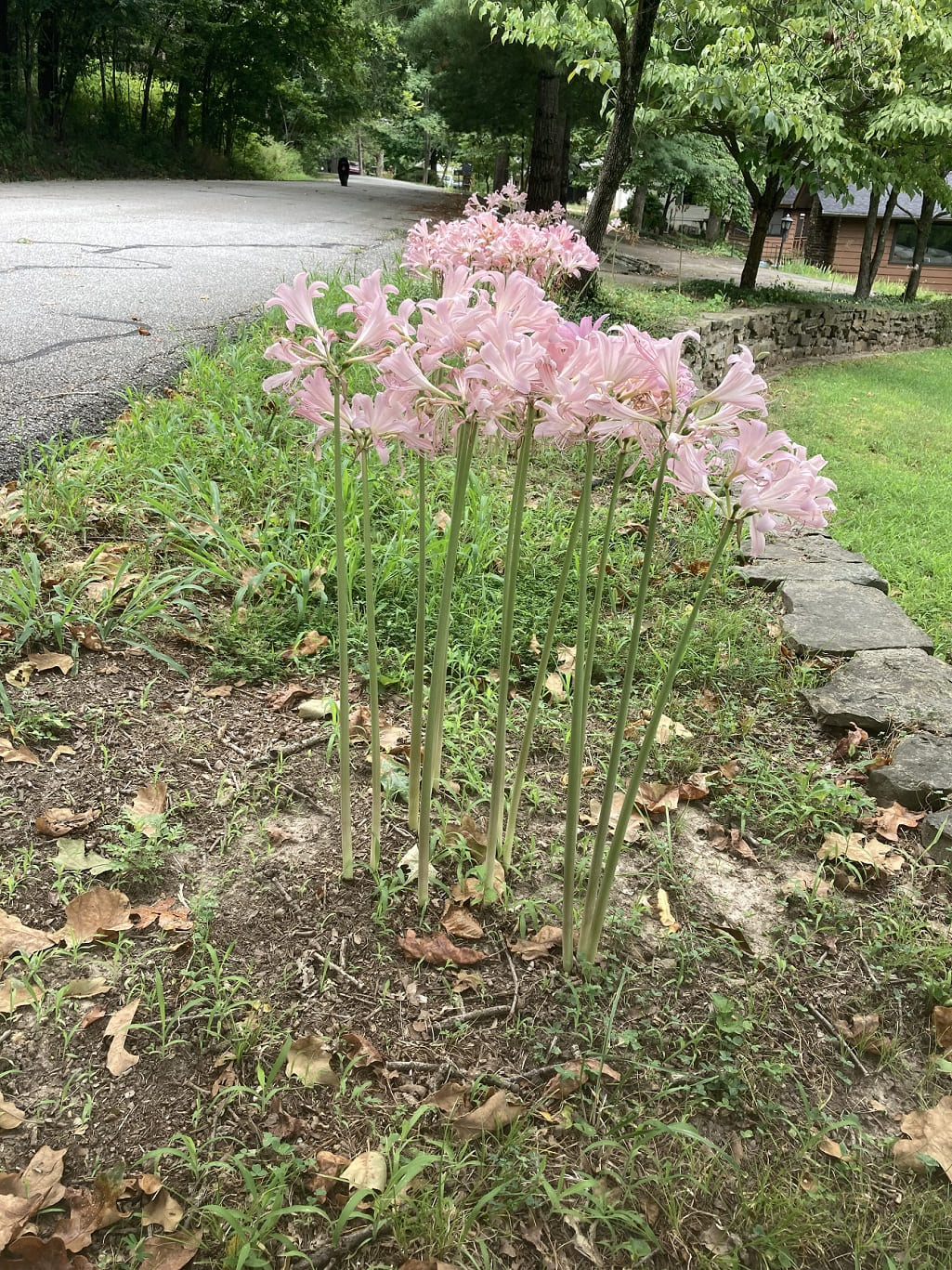
This unusual cycle represents an evolutionary adaptation to their native Asian climate, where wet springs provide energy for growth, followed by hot, dry summers that would stress most flowering plants.
The timing is so predictable that experienced gardeners can almost set their calendars by it—surprise lilies bloom faithfully each August regardless of weather variations.
Growing Your Own Garden Magic
The wonderful news about surprise lilies is that they’re remarkably easy to grow once you understand their needs. These hardy plants thrive in USDA zones 5b through 8a, with some reports of success in protected spots as cold as zone 5a and as warm as zone 8b.
Their accommodating nature has made them beloved pass-along plants, traveling from garden to garden as generous neighbors share their multiplying bulbs.
Choosing the Perfect Location
Surprise lilies adapt to various conditions, but understanding their preferences ensures the best performance. They thrive in full sun to partial shade, with full sun producing the most robust blooms in northern gardens. In hotter southern regions, afternoon shade can help flowers last longer and prevents the intense heat from shortening the bloom period.
Soil drainage is absolutely critical—these bulbs cannot tolerate waterlogged conditions, which cause rot during their summer dormancy. They’re surprisingly tolerant of different soil types, from sandy loam to heavy clay, as long as excess water can drain away.
If your soil tends to stay wet, consider adding compost to improve drainage or creating raised beds. A slightly acidic to neutral soil pH between 6.0 and 7.0 is ideal, though they’ll adapt to a wider range.
Location permanence is equally important. Surprise lilies resent being moved and may refuse to bloom for one to two years after transplanting. Choose a spot where they can remain undisturbed for many years, allowing them to form the substantial clumps that create the most dramatic display.
Planting for Success
Timing your planting correctly sets the stage for years of enjoyment. Fall planting is ideal, allowing bulbs to establish roots before winter dormancy. Early spring works too, though fall-planted bulbs typically perform better their first year. Avoid planting during their summer dormancy period when bulbs are most vulnerable to disturbance.
Plant bulbs 5-8 inches deep measured to the base, with the neck just below the soil surface. In marginal hardiness zones, planting slightly deeper provides extra winter protection. Space bulbs 6-8 inches apart initially—they’ll multiply and fill in over time, so resist the urge to crowd them from the start.

Managing expectations during the establishment period is crucial. Don’t expect blooms the first year after planting, and sometimes even foliage might not appear until the second spring if bulbs have been stressed by shipping or handling.
This patience pays off handsomely once they’re established, as mature clumps can persist and bloom reliably for decades.
Care Through the Seasons
One of the most appealing aspects of surprise lilies is their low-maintenance nature once established. During their spring growing season, provide moderate water if rainfall is insufficient, but avoid overwatering. Many successful growers rarely water their established plants, relying instead on natural precipitation.
As foliage begins to yellow in late spring, resist the urge to cut it back—the leaves need to complete their energy storage process naturally. Once they’ve died back completely, the plants enter their drought-tolerant dormancy period. This is when many gardeners forget they exist, making their August reappearance all the more surprising.
👉 Here’s How and Why to Deadhead Daylilies for Boosting Blooms
Fertilizing isn’t essential for healthy plants, but a light application of balanced fertilizer in early spring when foliage emerges can boost performance. Avoid high-nitrogen fertilizers that promote excessive leaf growth at the expense of blooms.
Winter protection becomes important in zones 5b and 6a. After the ground begins to freeze, apply a 2-inch layer of loose mulch like straw or shredded oak leaves around the planting area. Remove the mulch in early spring as new growth begins to emerge.
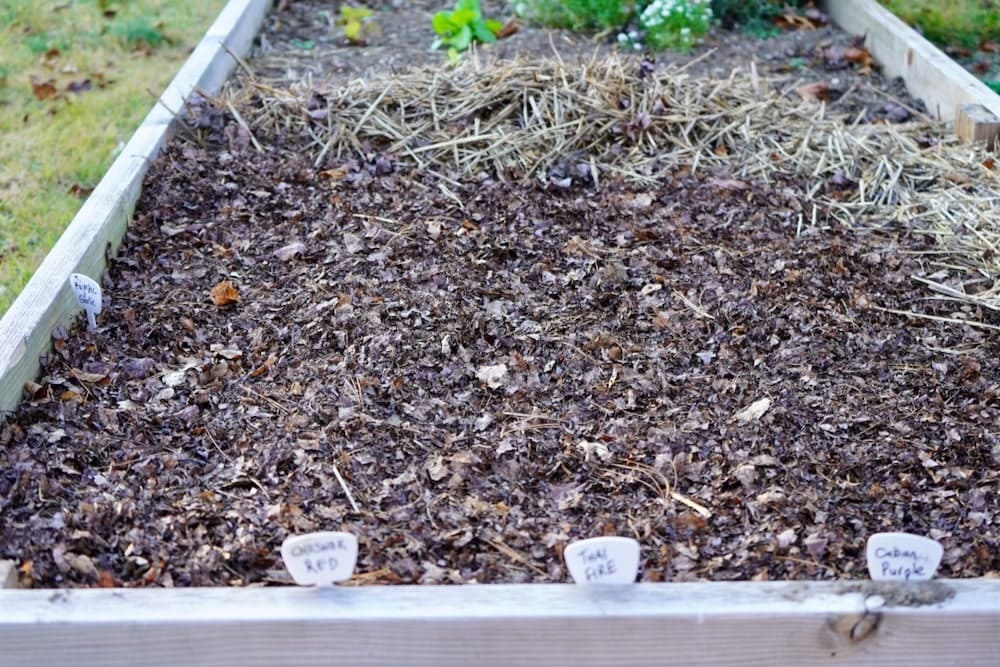
👉 Here’s How to Turn Fall Leaves into Soil Enriching Mulch For a Nutrient-Rich Garden
Design Strategies for Seasonal Beauty
The biggest challenge with surprise lilies isn’t growing them—it’s integrating them thoughtfully into your landscape design. Their seasonal disappearing act and sudden reappearance require creative planning to maintain garden interest year-round.
Companion Planting Solutions
Since surprise lilies essentially vanish for several months each year, strategic companion planting becomes essential. Low-growing perennials that provide consistent foliage work beautifully as living mulch. Ajuga, pachysandra, wild ginger, or creeping phlox create attractive groundcover while allowing the dramatic flower stalks to emerge unimpeded.
👉 Explore Top 22 Evergreen Junipers for Ground Cover and Garden Protection
Hostas make exceptional companions, offering attractive foliage that remains beautiful throughout surprise lilies’ dormant period. The contrasting textures—broad hosta leaves against elegant lily stems—create stunning combinations.
Ferns, coral bells, and astilbe also complement surprise lilies wonderfully, providing seasonal interest without competing for attention during the August bloom show.
Consider the timing of companion plants carefully. Summer-blooming perennials like black-eyed Susan, bee balm, or joe-pye weed can fill the visual gap during dormancy, then serve as attractive backdrops when surprise lilies take center stage.
👉 Discover Why Marigolds Are the Ultimate Companion Plant for Your Garden
Landscape Applications
Surprise lilies excel in naturalized settings where their wild, unexpected appearance feels perfectly at home. Woodland edges, meadow areas, or large sweeps under deciduous trees showcase their dramatic emergence beautifully. Here, their ability to thrive with minimal care makes them ideal for low-maintenance landscapes.
For maximum impact, plant them in generous groups rather than scattered individuals. A mass of 15-20 bulbs planted in flowing curves creates breathtaking displays that justify their “surprise” moniker. The effect when dozens of pink trumpets suddenly appear is truly magical.
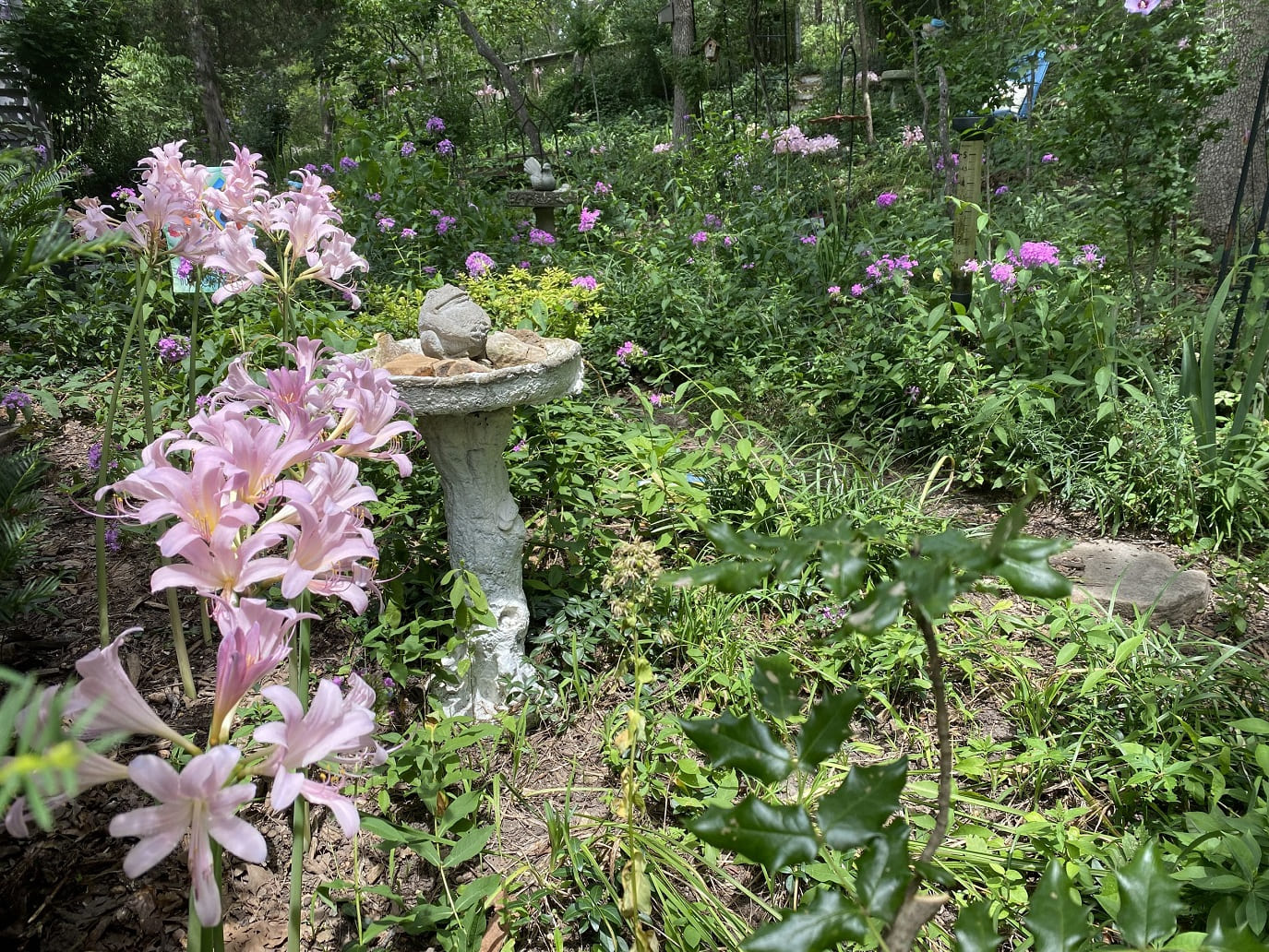
In formal gardens, tuck surprise lilies into mixed perennial borders where their sudden appearance becomes a delightful surprise rather than a jarring interruption. Position them behind earlier-blooming perennials that will provide coverage during their dormant period.
👉 Here’s How to Create a Harmonious Garden: A Guide to Beautiful Design
Multiplication and Sharing the Magic
One of my favorite aspects of surprise lilies is their generous nature—they’re the ultimate pass-along plant, embodying gardening’s spirit of sharing. Every few years, your original bulbs will have produced numerous offsets, ready to expand your own plantings or share with fellow gardeners.
Division Timing and Technique:
The best time to divide surprise lilies is during late summer after blooming but before the stems die back completely, typically in late August or early September. You can also divide during their dormant period in early summer, though locating dormant bulbs requires careful marking of their locations.
Signs that division is needed include reduced blooming, overcrowded foliage in spring, or simply the desire to share or relocate bulbs. Carefully dig around the entire clump with a garden fork, working outward from the center to avoid damaging bulbs. Lift the entire mass and gently separate the offsets—baby bulbs that have formed around the original.
Replant divisions immediately at the proper depth in their new locations. Water thoroughly after planting and mark the areas clearly, as it’s easy to forget where you’ve planted dormant bulbs. Be patient with newly divided bulbs, as they typically skip blooming the year after division while reestablishing their root systems.
Understanding Varieties and Related Species
While Lycoris squamigera is the most common and cold-hardy surprise lily, exploring other species opens up exciting possibilities for gardeners in appropriate climates.
Lycoris radiata, the red spider lily, produces dramatic scarlet blooms with long, curved stamens that create a spider-like appearance. Less cold-hardy than its pink cousin, it thrives in zones 7-10 and has naturalized throughout much of the southeastern United States.
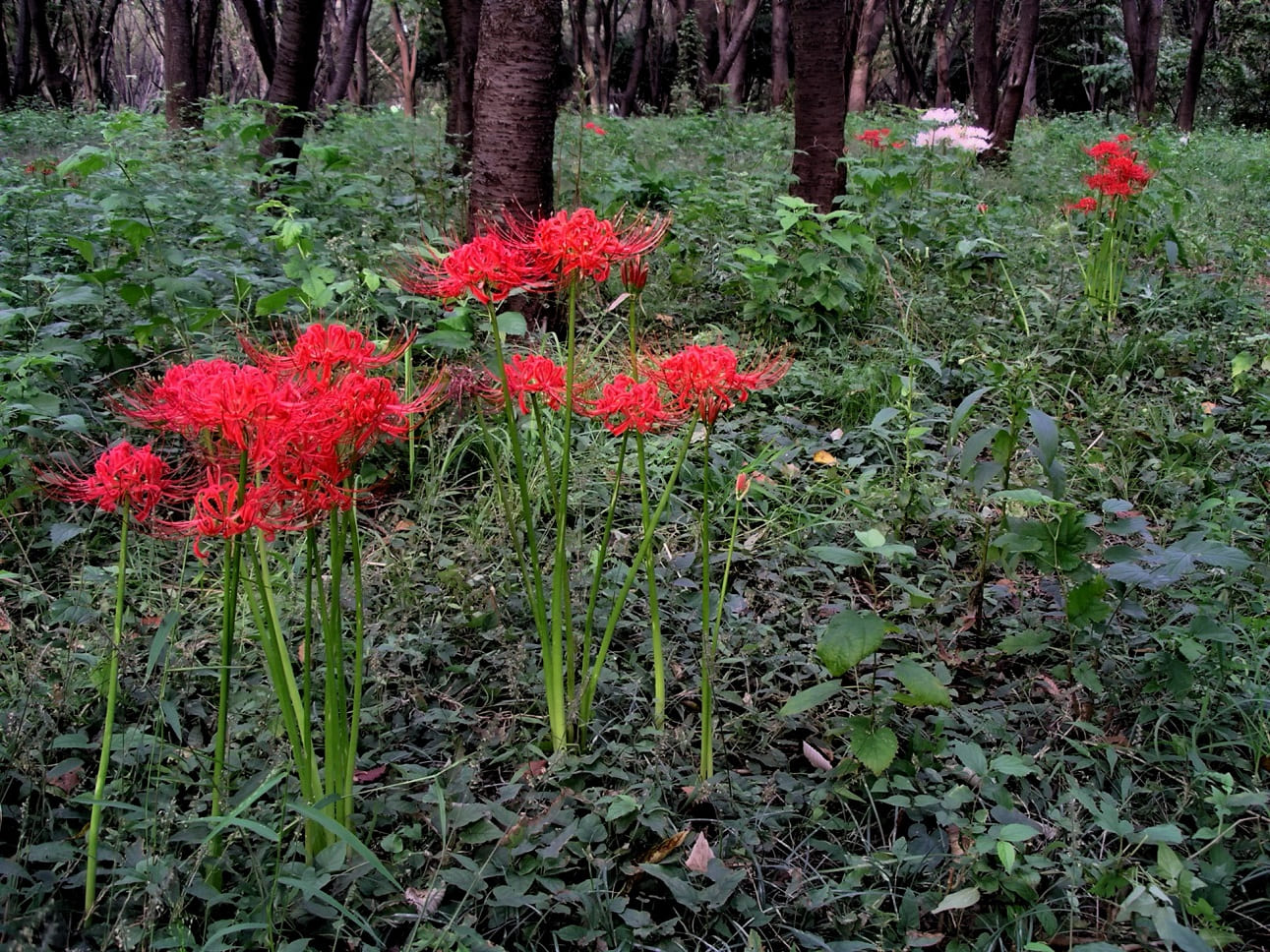
Lycoris caldwellii offers creamy white to pale yellow flowers and represents one of the few hardy alternatives to the standard pink.
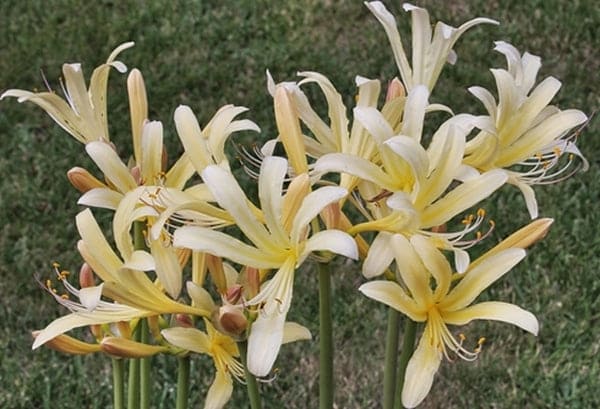
Lycoris sprengeri produces delicate pink blooms with blue highlights but requires protection in northern zones.
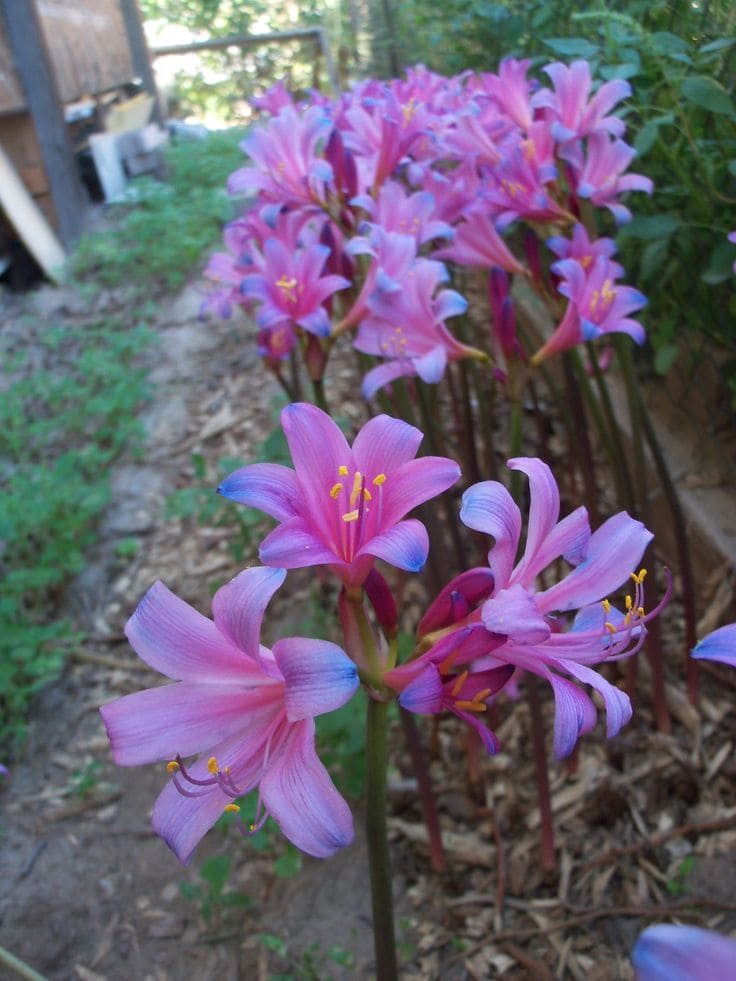
For adventurous gardeners, Lycoris incarnata creates an almost candy-striped effect with pale pink petals marked by purple midribs.
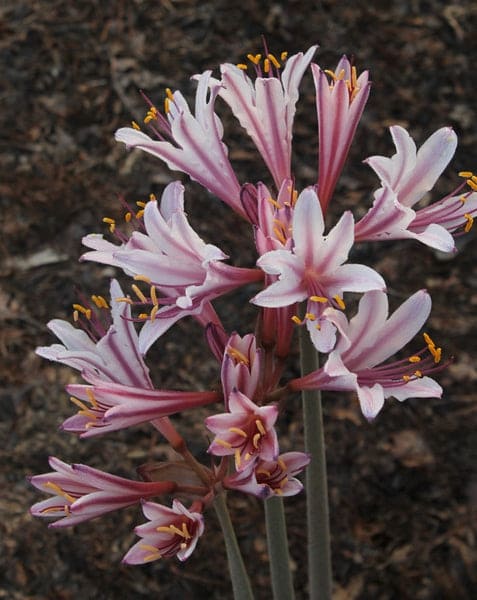
Specialty nurseries occasionally offer hybrid varieties developed by breeders in Asia, though these remain rare in American commerce. The scarcity of varieties in the trade partly reflects the challenge of shipping these bulbs, which don’t store well in dry conditions like typical spring bulbs.
Troubleshooting Common Challenges
Understanding why surprise lilies sometimes fail to perform helps ensure long-term success. The most common complaint is lack of blooming, which usually stems from one of several causes.
Newly planted or recently divided bulbs often take two to three years to bloom as they establish extensive root systems. This extended establishment period frustrates impatient gardeners but reflects the plant’s energy investment in long-term survival.
Bulbs planted too deeply may produce foliage but fail to flower—if you suspect this, carefully lift and replant at the correct depth.
In zones 9 and warmer, insufficient winter chilling prevents proper flower bud formation. Surprise lilies require vernalization—a period of cold temperatures—to initiate flowering. This explains why they may produce healthy foliage but no blooms in very warm climates.
Poor drainage during the dormant period can cause bulb rot, leading to gradual decline or sudden disappearance. If you notice reduced performance in established clumps, check soil drainage and consider relocating to a better-drained site.
Pest problems are remarkably rare with surprise lilies. Their toxic properties make them resistant to deer, rabbits, and most insects. Occasionally, aphids might appear on flower stalks, easily controlled with insecticidal soap. Lily leaf beetles can occasionally be problematic but are rarely serious enough to warrant treatment in established plantings.
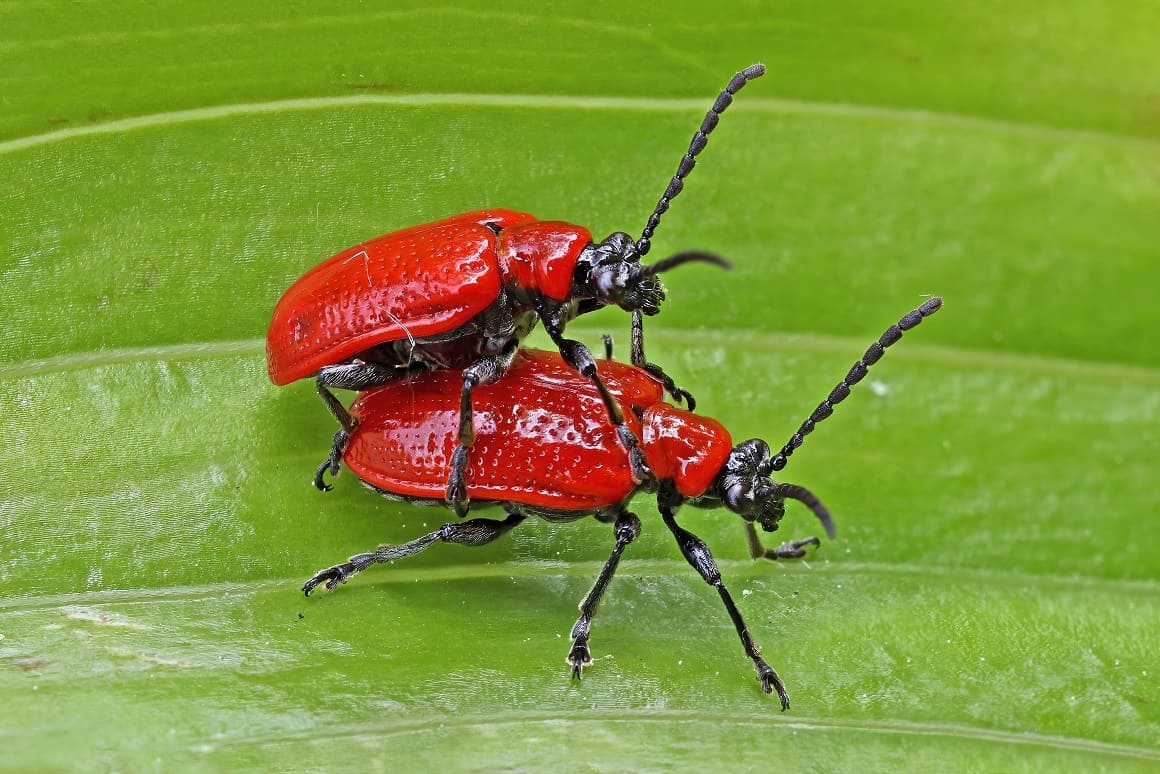
The Fragrant Finale
One aspect of surprise lilies that often goes unmentioned is their delightful fragrance. The sweet, spicy scent carries well on still August evenings, adding another dimension to their appeal.
This fragrance makes them excellent cut flowers—harvest stems when buds are just beginning to open for the longest vase life. The cut flowers last well and continue opening in the vase, bringing their magic indoors.
Embracing Garden Mysteries
In our age of instant gratification and predictable gardens, surprise lilies offer something increasingly precious: genuine anticipation and wonder. They teach us patience, reward our faith, and remind us that some of gardening’s greatest pleasures come not from controlling nature, but from celebrating its mysteries.
These remarkable plants connect us to gardening’s past through their role as pass-along plants, traveling from garden to garden as living heirlooms. Each August when they bloom, we’re linked not just to the gardener who shared them with us, but to the generations of gardeners who recognized their magic and ensured their survival.
Whether you’re drawn to their practical benefits—deer resistance, drought tolerance, and minimal care requirements—or their emotional appeal as living connections to gardening traditions, surprise lilies deserve a place in every garden. Plant them this fall, mark your calendar for next August, and prepare to be amazed.
After all, in a world that often feels predictable, who couldn’t use a little more magic appearing in their garden each summer?
Frequently Asked Questions
- How long do surprise lilies live?
With proper care, surprise lily bulbs can persist for decades. Many gardeners treasure clumps that are 30-50 years old, passed down through generations of plant sharing.
- Are surprise lilies dangerous to children and pets?
Yes, all parts of the plant contain alkaloids that are toxic if ingested, causing nausea, vomiting, and more serious symptoms in large quantities. However, this same toxicity makes them naturally deer and rodent resistant.
- Can I grow surprise lilies in containers?
While possible, container cultivation is challenging due to their deep root systems and need for proper dormancy conditions. They’re much better suited to garden cultivation where they can establish extensive root systems.
- Why do established plants sometimes stop blooming?
This usually indicates overcrowding and the need for division, insufficient winter chilling in warm climates, or changes in growing conditions such as increased shade or poor drainage.
- How quickly do they multiply?
Surprise lilies increase moderately through bulb offsets, typically doubling their numbers every 3-5 years under good conditions. This steady but not aggressive spread makes them ideal for naturalizing without becoming invasive.
- Can I plant them where other bulbs have failed?
Often yes, since surprise lilies tolerate a wider range of conditions than many spring bulbs and their summer dormancy helps them avoid many common bulb problems. Their different growing season also means they don’t compete directly with spring-blooming bulbs.
